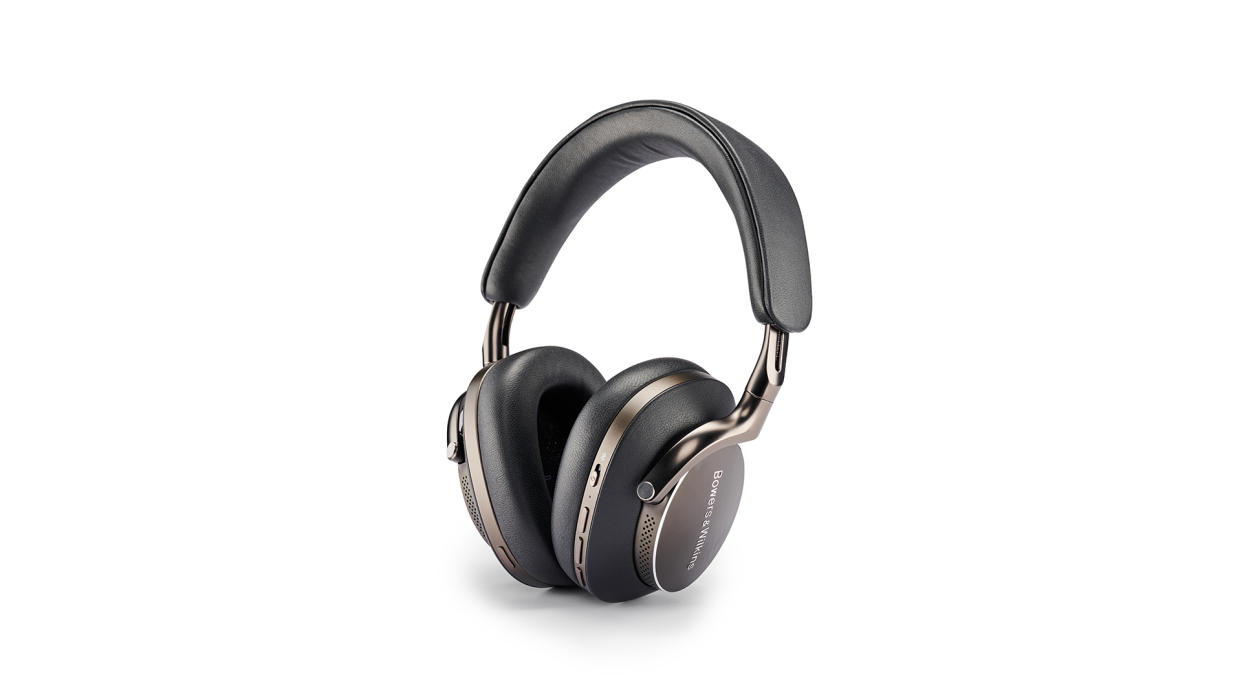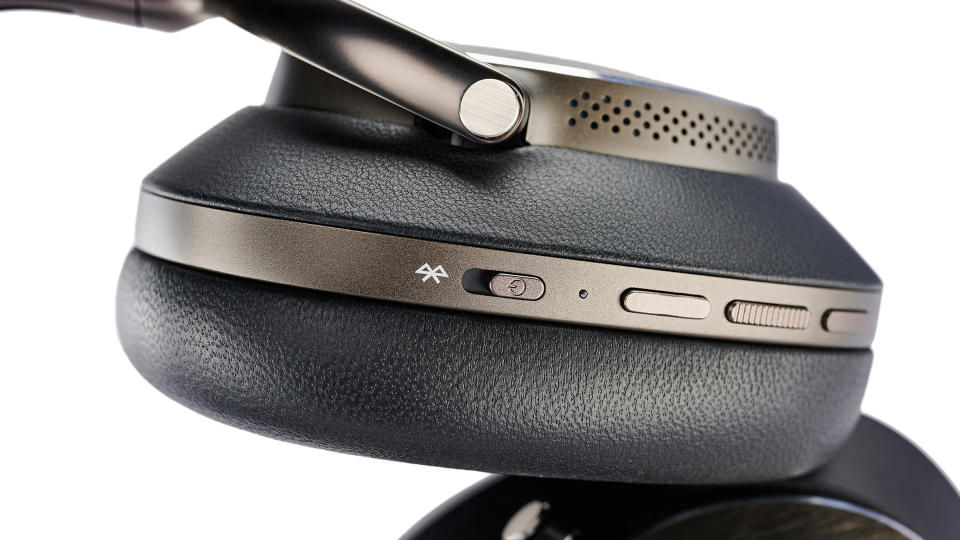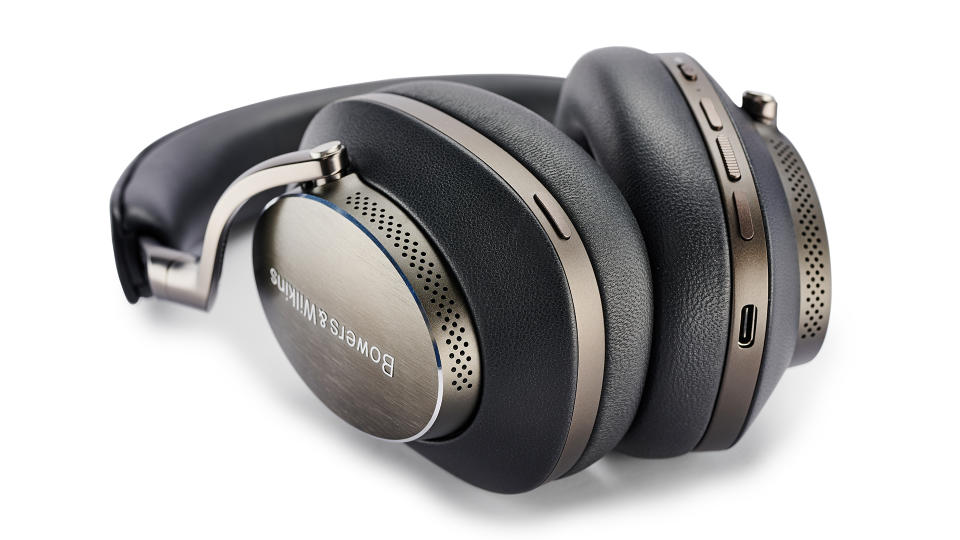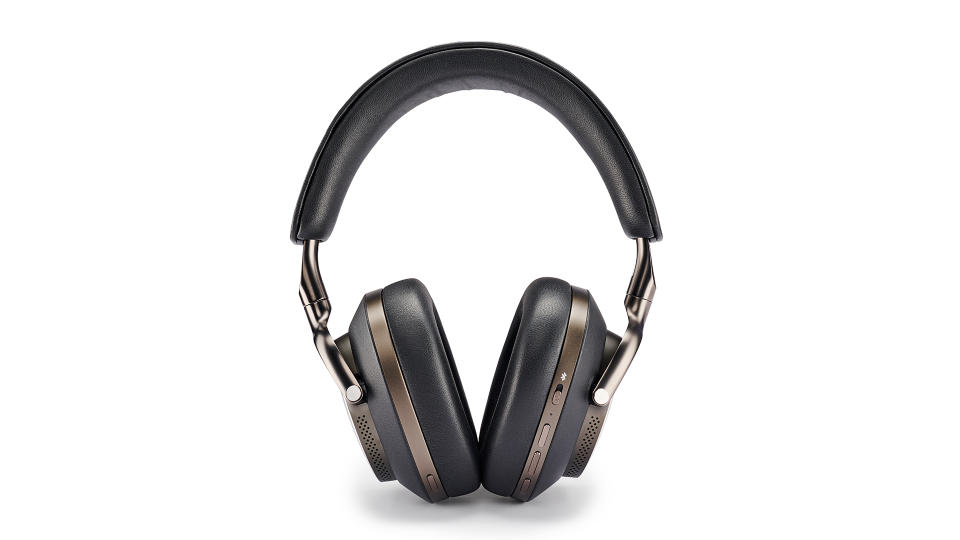Bowers & Wilkins Px8

Bowers & Wilkins seems particularly bullish about its new range-topping wireless headphones, the Px8. There’s the hefty asking price for starters, which easily shades that of Apple’s older but still ambitious AirPods Max. Then comes the press release that makes claims of reference standards across the board for performance, build and finish. That’s fighting talk, but at least it is backed up with real substance.
Design

For starters, the Px8 certainly look the part. They stick to the company’s trademark classy aesthetic design that superbly manages the difficult balance between showy and luxurious. The high price of these headphones is certainly reflected in the quality of the materials, which have taken a big step up over the otherwise similar-looking (and cheaper) Bowers & Wilkins Px7 S2 headphones we reviewed a few months ago.
There is lovely soft Nappa leather on the headband, earcups and earpads, which feels really pleasant to the touch. You can have it in two flavours – black or tan – and both look smart. Elsewhere, the cast aluminium arm structure is beautifully finished and feels precisely engineered in the way it slides and pivots. Unlike some rivals though, all this premium goodness doesn’t add much in the way of weight, with the Px8 coming in at an entirely reasonable 320g. That is around 60g less than its rival from Apple. Add this reasonable weight to the well-shaped headband and nicely-designed earpads, and the result is a pleasing degree of comfort, even over extended use.
The biggest technical difference between these headphones and their cheaper sibling comes down to a change of cone material for the 40mm driver on each side, from bio-cellulose (paper) to carbon fibre. This carbon cone is claimed to be lighter, more rigid and better controlled in its behaviour, so reducing distortion and improving transparency. The rest of the drive unit is relatively unchanged bar tweaks to the motor system to account for the reduced mass of the new cone.
Beyond the cone material, the spec sheet reads the same as for the Px7 S2, but that’s no bad thing. The Px8 have Bluetooth 5.2 with aptX Adaptive compatibility, four microphones for noise cancelling plus another two for voice pick-up in phone calls and a claimed 30-hour battery life. That stamina is certainly enough to cover long-distance flights and most other use cases we can think of, but it’s hard to ignore the fact that cheaper alternatives such as the new Sennheiser Momentum 4 Wireless can double that number.
Features

We’re glad Bowers & Wilkins has kept faith with physical buttons on the earcups rather than going the touch control route. We find this approach more reliable and intuitive which means less fumbling around when on the move. The precise-feeling controls are pretty simple with the button on the left-hand earcup either switching through noise cancelling options – on, passthrough and off – or activating your phone’s voice assistant, depending on how things are configured in the partnering app. The recently upgraded Bowers & Wilkins Music app also includes adjustments for bass and treble tone controls and the sensitivity of the wear sensor.
This app has evolved significantly since we last looked at it and can now link directly to music services such as Tidal, Qobuz and Deezer so that everything can be controlled from one place. It also helps to produce a more cohesive user experience if you own other network-linked Bowers & Wilkins products, all of which can be controlled from this app.
Bowers & Wilkins Px8 tech specs

Bluetooth 5.2 with aptX Adaptive
Battery life 30 hours
Drive unit 40mm carbon cone
Charging USB-C
Noise cancelling Yes
Weight 320g
The app proves stable in use though we have issues with the wear sensor feature. The idea is that the music stops when you take the headphones off and restarts when you put them back on again. There are three levels of sensitivity, but even on the lowest setting, we find that the music occasionally halts unexpectedly, even when we haven’t removed the headphones. Admittedly, we’re usually walking somewhere, but Apple’s AirPods Max manage just fine in such circumstances. We end up turning the wear function off to avoid annoyance. On a positive note, the Px8’s structure is low-resonance and deals with footfall vibration better than most.
The Px8 come with a USB-C to USB-C cable for connection directly to your computer and also a USB-C to 3.5mm alternative. There is a definite drop in performance when we use the 3.5mm option, but that’s to be expected given the extra processing involved in the signal path. The all-USB-C link sounds better, though we notice that there is a lack of low-level volume adjustment from our MacBook Pro. It is not an issue when listening at higher levels but the volume steps are way too coarse for quieter sessions.
Noise cancelling is generally good. Things are nice and quiet during our train journeys though sudden or non-regular sounds such as workers digging the street or traffic noise still manage to break through. But, the same could be said for most rivals. If absolute quietness is a priority then Sony’s cheaper WH-1000XM5 do even better. But, it is important to note that those Sonys don’t sound as good.
Sound

Anyone familiar with recent efforts from Bowers & Wilkins won’t be surprised with what the Px8 deliver in sound quality, but they will still be impressed. There is a level of clarity and insight here that we haven’t heard bettered at this level. Performance is a clear step ahead of talented but cheaper alternatives such as the aforementioned Sonys or the new Sennheiser Momentum 4 in pretty much every area. There is more precision and clarity than the Apple AirPods Max too.
We listen to Raye’s All Of My Love and the Px8 sound right at home, thumping out bass with enthusiasm. It is a taut and controlled sound that is packed with excitement, provided you listen at higher levels. Drop the volume level down and some of the music’s sparkle and energy fade. This kind of thing isn’t uncommon in products such as this, but the Px8 do seem to suffer more than most. Interestingly, we’ve often noted a similar trait in the company’s speakers too. Maybe B&W needs to pay more attention to performance at lower volume levels during the product development process.
Volume issues aside it is all good news here. The Px8’s midrange is crisp and clear, communicating vocal nuances superbly. These headphones reveal an impressive amount of detail and just as importantly present it in a musically cohesive way. There is a reassuring sense of control here and the ability to track low-level instrumental strands, even when the music gets busy.
You also get a good sense of rhythmic drive along with all the analysis. These B&Ws are a fun listen that communicate the energy in the music well. It helps that they are impressively agile and responsive, tracking the music signal with the determination of a bloodhound.
We switch to Stravinsky’s The Rite Of Spring and the Px8 continue to shine. They convey the music’s dynamic sweeps superbly and reveal plenty of low-level detail in the recording. We’re impressed by the headphones’ composure when the music gets demanding and the feeling of scale and authority they generate. This is something that headphones as a breed don’t tend to do so well.
This is a refined listen too without sounding overly smooth. The Px8 are certainly revealing enough to show up shortcomings in the source or recording, so you’ll need to make sure the signal feed into them is good enough to allow them to shine. A slightly cool tonal balance doesn’t help them to be forgiving either, though they won’t go out of their way to make things sound worse than they are.
We try the Px8’s call quality and it is generally decent. We have no issue with clarity, though voices come through with a bit of an unwanted edge. Background noise levels are acceptably low but not outstanding and wind noise on a blustery day can be a slight issue, as it often is on headphones such as this.
Verdict

Overall, the Bowers & Wilkins Px8 are hugely capable performers that justify their price with a combination of build and sound quality that cheaper alternatives just can’t match. Apple’s AirPods Max may have kick-started the market for higher-end wireless noise-cancelling headphones but, to our ears, these B&Ws deliver even more in the way of musical insight and enjoyment.
There are some niggles but nothing that comes close to denting our enthusiasm for these headphones. They are a fine effort that deserve serious consideration if you are buying at this level.
SCORES
Sound 5
Build 5
Features 5
MORE:
Read our Apple AirPods Max review
Also consider the Mark Levinson No5909
Our pick of the best noise-canceling headphones
